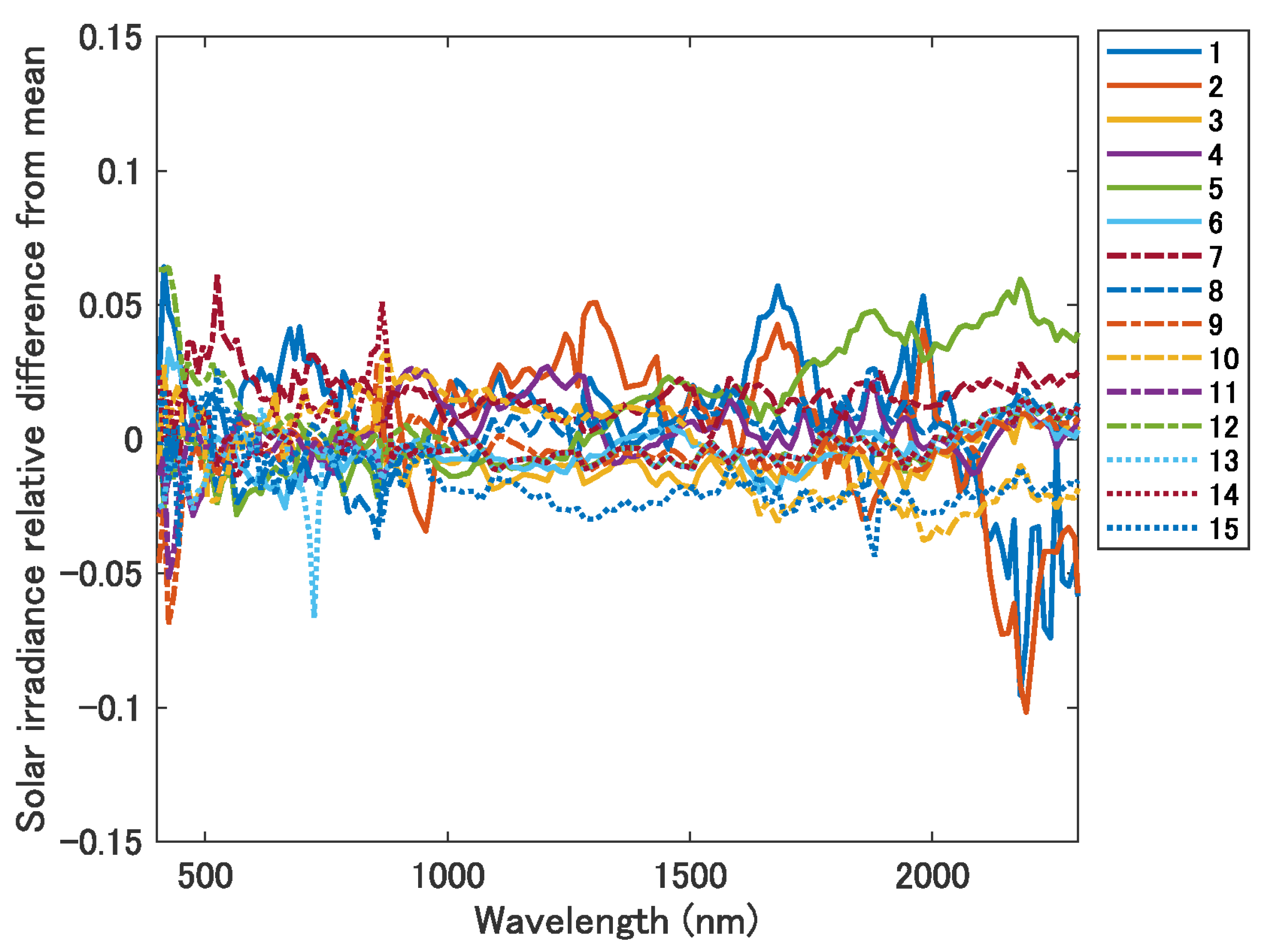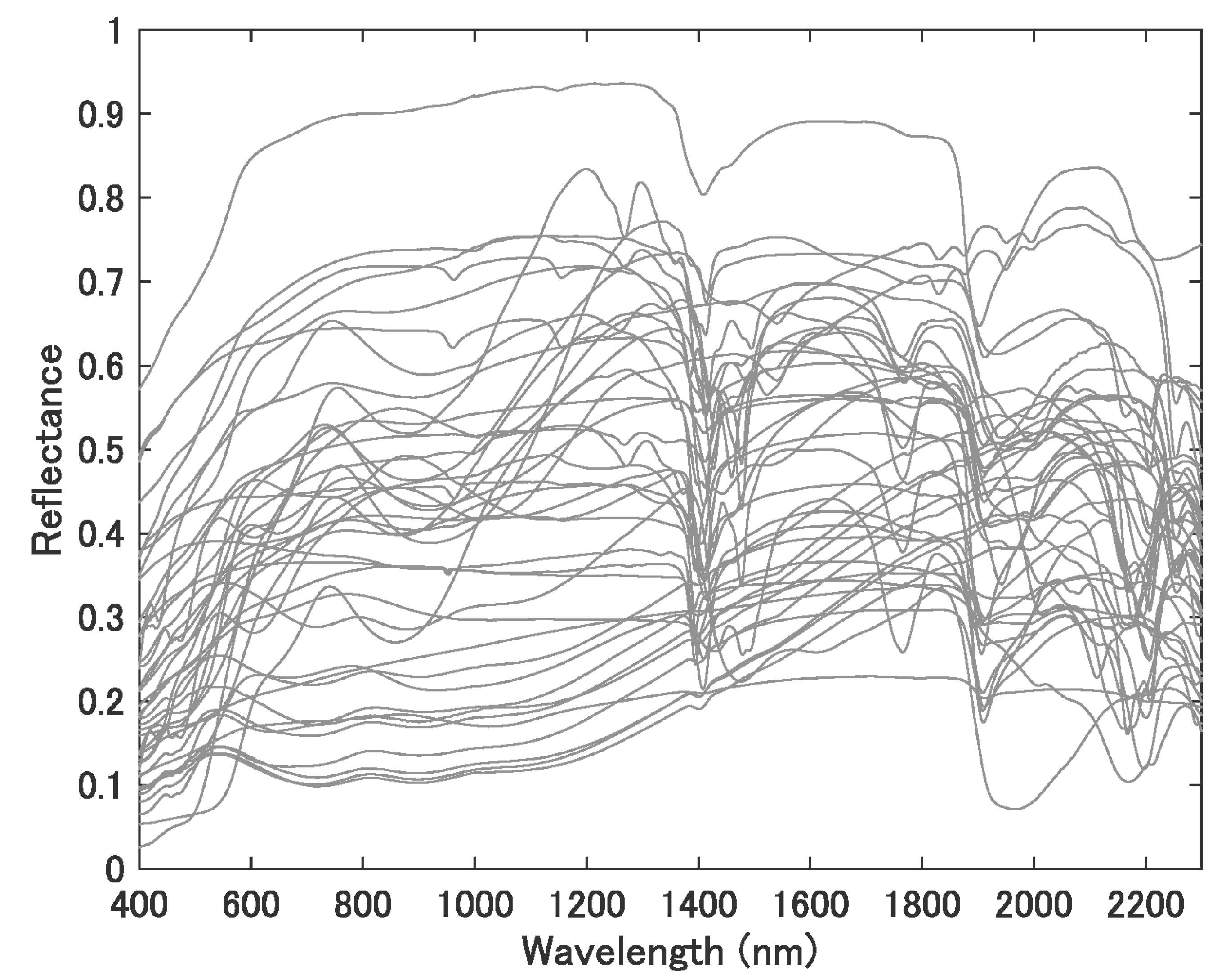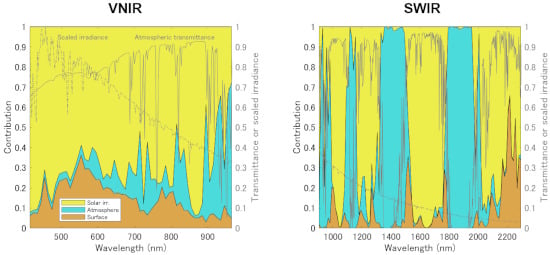Sensitivity Analysis Method for Spectral Band Adjustment between Hyperspectral Sensors: A Case Study Using the CLARREO Pathfinder and HISUI
Abstract
:1. Introduction
2. Derivation of Propagated Errors
2.1. Radiance-to-Radiance Conversion
2.2. Reflectance-to-Radiance Conversion
3. Numerical Simulations
3.1. Sensors and Their Spectral Band Adjustment
3.2. RSR and Band Assumptions for Spectral Convolution
3.3. Solar Irradiance Models
3.4. Spectral Parameters Used to Describe the Atmosphere
3.5. Soil Reflectances
3.6. Computation of Standard Deviations and Covariances for the Sensitivity Analysis
3.7. Sensitivity Analysis
3.8. Evaluation of the Derived Equation
4. Results
4.1. Sensitivity Analysis
4.2. Evaluation of the Derived Equation
5. Discussion
6. Conclusions
Funding
Acknowledgments
Conflicts of Interest
Appendix A. Partial Derivatives of the Errors Propagated during the Radiance/Reflectance-to- Radiance Conversion
References
- Foerster, S.; Guanter, L.; Lopez, T.; Moreno, J.; Rast, M.; Schaepman, M.E. Guest Editorial: International Space Science Institute (ISSI) Workshop on Space-Borne Imaging Spectroscopy for Exploring the Earth’s Ecosystems. Surv. Geophys. 2019, 40, 297–301. [Google Scholar] [CrossRef]
- Müller, R.; Bachmann, M.; Alonso, K.; Carmona, E.; Cerra, D.; los Reyes, R.D.; Gerasch, B.; Krawczyk, H.; Ziel, V.; Heiden, U.; et al. Processing, Validation And Quality Control Of Spaceborne Imaging Spectroscopy Data From DESIS Mission on the ISS. In Proceedings of the IGARSS 2018—2018 IEEE International Geoscience and Remote Sensing Symposium, Valencia, Spain, 22–27 July 2018; pp. 189–191. [Google Scholar] [CrossRef]
- Matsunaga, T.; Iwasaki, A.; Tsuchida, S.; Iwao, K.; Nakamura, R.; Yamamoto, H.; Kato, S.; Obata, K.; Kashimura, O.; Tanii, J.; et al. HISUI Status Toward FY2019 Launch. In Proceedings of the IGARSS 2018—2018 IEEE International Geoscience and Remote Sensing Symposium, Valencia, Spain, 22–27 July 2018; pp. 160–163. [Google Scholar] [CrossRef]
- Green, R.O. The Earth Surface Mineral Dust Source Investigation (EMIT). Available online: https://hyspiri.jpl.nasa.gov/downloads/2018_Workshop/day1/13_HyspIRI_EMIT_Overview_20180815b.pdf (accessed on 19 April 2019).
- CLARREO Pathfinder Mission Team. Pathfinder Mission for Climate Absolute Radiance and Refractivity Observatory (CLARREO); Technical Report; National Aeronautics and Space Administration: Washington, DC, USA, 2016.
- Obata, K.; Tsuchida, S.; Nagatani, I.; Yamamoto, H.; Kouyama, T.; Yamada, Y.; Yamaguchi, Y.; Ishii, J. An overview of ISS HISUI hyperspectral imager radiometric calibration. In Proceedings of the IGARSS 2018—2018 IEEE International Geoscience and Remote Sensing Symposium, Beijing, China, 10–15 July 2016; pp. 1924–1927. [Google Scholar] [CrossRef]
- Yamamoto, H.; Obata, K.; Tsuchida, S.; Kerr, G.; Bachmann, M. Cross-sensor calibration and validation between DESIS and HISUI Hyperspectral Imager on the International Space Station (ISS). In Proceedings of the 2016 IEEE International Geoscience and Remote Sensing Symposium (IGARSS), Beijing, China, 10–15 July 2016; pp. 1928–1930. [Google Scholar] [CrossRef]
- Chander, G.; Markham, B.L.; Barsi, J.A. Revised Landsat-5 Thematic Mapper Radiometric Calibration. IEEE Geosci. Remote Sens. Lett. 2007, 4, 490–494. [Google Scholar] [CrossRef]
- Chander, G.; Mishra, N.; Helder, D.L.; Aaron, D.B.; Angal, A.; Choi, T.; Xiong, X.; Doelling, D.R. Applications of Spectral Band Adjustment Factors (SBAF) for Cross-Calibration. IEEE Trans. Geosci. Remote Sens. 2013, 51, 1267–1281. [Google Scholar] [CrossRef]
- Lukashin, C.; Wielicki, B.A.; Young, D.F.; Thome, K.; Jin, Z.; Sun, W. Uncertainty Estimates for Imager Reference Inter-Calibration With CLARREO Reflected Solar Spectrometer. IEEE Trans. Geosci. Remote Sens. 2013, 51, 1425–1436. [Google Scholar] [CrossRef]
- Roithmayr, C.M.; Lukashin, C.; Speth, P.W.; Kopp, G.; Thome, K.; Wielicki, B.A.; Young, D.F. CLARREO Approach for Reference Intercalibration of Reflected Solar Sensors: On-Orbit Data Matching and Sampling. IEEE Trans. Geosci. Remote Sens. 2014, 52, 6762–6774. [Google Scholar] [CrossRef] [Green Version]
- Wu, A.; Xiong, X.; Jin, Z.; Lukashin, C.; Wenny, B.N.; Butler, J.J. Sensitivity of Intercalibration Uncertainty of the CLARREO Reflected Solar Spectrometer Features. IEEE Trans. Geosci. Remote Sens. 2015, 53, 4741–4751. [Google Scholar] [CrossRef]
- Lukashin, C.; Jin, Z.; Kopp, G.; MacDonnell, D.G.; Thome, K. CLARREO Reflected Solar Spectrometer: Restrictions for Instrument Sensitivity to Polarization. IEEE Trans. Geosci. Remote Sens. 2015, 53, 6703–6709. [Google Scholar] [CrossRef]
- Teillet, P.; Barker, J.; Markham, B.; Irish, R.; Fedosejevs, G.; Storey, J. Radiometric cross-calibration of the Landsat-7 ETM+ and Landsat-5 TM sensors based on tandem data sets. Remote Sens. Environ. 2001, 78, 39–54. [Google Scholar] [CrossRef] [Green Version]
- Mishra, N.; Haque, M.O.; Leigh, L.; Aaron, D.; Helder, D.; Markham, B. Radiometric Cross Calibration of Landsat 8 Operational Land Imager (OLI) and Landsat 7 Enhanced Thematic Mapper Plus (ETM+). Remote Sens. 2014, 6, 12619–12638. [Google Scholar] [CrossRef] [Green Version]
- Uprety, S.; Cao, C. Suomi NPP VIIRS reflective solar band on-orbit radiometric stability and accuracy assessment using desert and Antarctica Dome C sites. Remote Sens. Environ. 2015, 166, 106–115. [Google Scholar] [CrossRef]
- Barrientos, C.; Mattar, C.; Nakos, T.; Perez, W. Radiometric Cross-Calibration of the Chilean Satellite FASat-C Using RapidEye and EO-1 Hyperion Data and a Simultaneous Nadir Overpass Approach. Remote Sens. 2016, 8, 612. [Google Scholar] [CrossRef]
- Doelling, D.R.; Lukashin, C.; Minnis, P.; Scarino, B.; Morstad, D. Spectral Reflectance Corrections for Satellite Intercalibrations Using SCIAMACHY Data. IEEE Geosci. Remote Sens. Lett. 2012, 9, 119–123. [Google Scholar] [CrossRef]
- Obata, K.; Tsuchida, S.; Yamamoto, H.; Thome, K. Cross-Calibration between ASTER and MODIS Visible to Near-Infrared Bands for Improvement of ASTER Radiometric Calibration. Sensors 2017, 17, 1793. [Google Scholar] [CrossRef] [PubMed]
- Teillet, P.; Slater, P.; Ding, Y.; Santer, R.; Jackson, R.; Moran, M. Three methods for the absolute calibration of the NOAA AVHRR sensors in-flight. Remote Sens. Environ. 1990, 31, 105–120. [Google Scholar] [CrossRef]
- Thome, K.J.; Biggar, S.F.; Wisniewski, W. Cross comparison of EO-1 sensors and other Earth resources sensors to Landsat-7 ETM+ using Railroad Valley Playa. IEEE Trans. Geosci. Remote Sens. 2003, 41, 1180–1188. [Google Scholar] [CrossRef]
- Lacherade, S.; Fougnie, B.; Henry, P.; Gamet, P. Cross Calibration Over Desert Sites: Description, Methodology, and Operational Implementation. IEEE Trans. Geosci. Remote Sens. 2013, 51, 1098–1113. [Google Scholar] [CrossRef]
- Verhoef, W.; Bach, H. Simulation of hyperspectral and directional radiance images using coupled biophysical and atmospheric radiative transfer models. Remote Sens. Environ. 2003, 87, 23–41. [Google Scholar] [CrossRef]
- Mousivand, A.; Verhoef, W.; Menenti, M.; Gorte, B. Modeling Top of Atmosphere Radiance over Heterogeneous Non-Lambertian Rugged Terrain. Remote Sens. 2015, 7, 8019–8044. [Google Scholar] [CrossRef] [Green Version]
- Yoshioka, H. Vegetation isoline equations for an atmosphere-canopy-soil system. IEEE Trans. Geosci. Remote Sens. 2004, 42, 166–175. [Google Scholar] [CrossRef]
- Baret, F.; Jacquemoud, S.; Hanocq, J. About the soil line concept in remote sensing. Adv. Space Res. 1993, 13, 281–284. [Google Scholar] [CrossRef]
- Yoshioka, H.; Huete, A.R.; Miura, T. Derivation of vegetation isoline equations in red-NIR reflectance space. IEEE Trans. Geosci. Remote Sens. 2000, 38, 838–848. [Google Scholar] [CrossRef]
- Yoshioka, H.; Miura, T.; Huete, A.; Ganapol, B. Analysis of Vegetation Isolines in Red-NIR Reflectance Space. Remote Sens. Environ. 2000, 74, 313–326. [Google Scholar] [CrossRef]
- Miura, M.; Obata, K.; Yoshioka, H. Vegetation isoline equations with first- and second-order interaction terms for modeling a canopy-soil system of layers in the red and near-infrared reflectance space. J. Appl. Remote Sens. 2015, 9, 095987. [Google Scholar] [CrossRef]
- Miura, M.; Obata, K.; Taniguchi, K.; Yoshioka, H. Improved Accuracy of the Asymmetric Second-Order Vegetation Isoline Equation over the RED-NIR Reflectance Space. Sensors 2017, 17, 450. [Google Scholar] [CrossRef] [PubMed]
- Obata, K.; Miura, T.; Yoshioka, H.; Huete, A.R. Derivation of a MODIS-compatible enhanced vegetation index from visible infrared imaging radiometer suite spectral reflectances using vegetation isoline equations. J. Appl. Remote Sens. 2013, 7, 073467. [Google Scholar] [CrossRef] [Green Version]
- Fan, X.; Liu, Y. Quantifying the Relationship Between Intersensor Images in Solar Reflective Bands: Implications for Intercalibration. IEEE Trans. Geosci. Remote Sens. 2014, 52, 7727–7737. [Google Scholar]
- Fan, X.; Liu, Y. A Generalized Model for Intersensor NDVI Calibration and Its Comparison With Regression Approaches. IEEE Trans. Geosci. Remote Sens. 2017, 55, 1842–1852. [Google Scholar] [CrossRef]
- Fan, X.; Liu, Y. Multisensor Normalized Difference Vegetation Index Intercalibration: A Comprehensive Overview of the Causes of and Solutions for Multisensor Differences. IEEE Geosci. Remote Sens. Mag. 2018, 6, 23–45. [Google Scholar] [CrossRef]
- Taylor, J.R. An Introduction to Error Analysis: The Study of Uncertainties in Physical Measurements, 2nd ed.; University Science Books: Mill Valley, CA, USA, 1997. [Google Scholar]
- Currey, C.; Bartle, A.; Lukashin, C.; Roithmayr, C.; Gallagher, J. Multi-Instrument Inter-Calibration (MIIC) System. Remote Sens. 2016, 8, 902. [Google Scholar] [CrossRef]
- Tanii, J.; Kashimura, O.; Ito, Y.; Iwasaki, A. Flight model performances of HISUI hyperspectral sensor onboard ISS (International Space Station). In Proceedings of the Sensors, Systems, and Next-Generation Satellites XX, Edinburgh, UK, 26–29 September 2016; Volume 10000, p. 104230Q. [Google Scholar] [CrossRef]
- Ogawa, K.; Konno, Y.; Yamamoto, S.; Matsunaga, T.; Tachikawa, T.; Komoda, M. Observation planning algorithm of a Japanese space-borne sensor: Hyperspectral Imager SUIte (HISUI) onboard International Space Station (ISS) as platform. In Proceedings of the Sensors, Systems, and Next-Generation Satellites XXI, Warsaw, Poland, 11–14 September 2017; Volume 10423. [Google Scholar]
- Arvesen, J.C.; Griffin, R.N.; Pearson, B.D. Determination of Extraterrestrial Solar Spectral Irradiance from a Research Aircraft. Appl. Opt. 1969, 8, 2215–2232. [Google Scholar] [CrossRef] [PubMed]
- Wehrli, C. Extraterrestrial Solar Spectrum. Publication No. 615, Physikalisch Meteorologisches Observatorium Davos + World Radiation Center (PMOD/WRC); PMOD/WRC: Davos Dorf, Switzerland, 1985. [Google Scholar]
- Colina, L.; Bohlin, R.C.; Castelli, F. The 0.12-2.5 micron Absolute Flux Distribution of the Sun for Comparison With Solar Analog Stars. Astron. J. 1996, 8, 307–315. [Google Scholar] [CrossRef]
- American Society for Testing and Materials. Standard Solar Constant and Zero Air Mass Solar Spectral Irradiance Tables. Standard E490-00. 2000. Available online: http://rredc.nrel.gov/solar/spectra/am0/ASTM2000.html (accessed on 15 December 2017).
- Thuillier, G.; Hersé, M.; Labs, D.; Foujols, T.; Peetermans, W.; Gillotay, D.; Simon, P.; Mandel, H. The Solar Spectral Irradiance from 200 to 2400 nm as Measured by the SOLSPEC Spectrometer from the Atlas and Eureca Missions. Sol. Phys. 2003, 214, 1–22. [Google Scholar] [CrossRef]
- Gueymard, C.A. The sun’s total and spectral irradiance for solar energy applications and solar radiation models. Sol. Energy 2004, 76, 423–453. [Google Scholar] [CrossRef]
- Fontenla, J.M.; Harder, J.; Livingston, W.; Snow, M.; Woods, T. High-resolution solar spectral irradiance from extreme ultraviolet to far infrared. J. Geophys. Res. Atmos. 2011, 116, D20108. [Google Scholar] [CrossRef]
- Coddington, O.; Lean, J.L.; Pilewskie, P.; Snow, M.; Lindholm, D. A Solar Irradiance Climate Data Record. Bull. Am. Meteorol. Soc. 2016, 97, 1265–1282. [Google Scholar] [CrossRef]
- Yeo, K.L.; Krivova, N.A.; Solanki, S.K.; Glassmeier, K.H. Reconstruction of total and spectral solar irradiance from 1974 to 2013 based on KPVT, SoHO/MDI, and SDO/HMI observations. Astron. Astrophys. 2014, 570, A85. [Google Scholar] [CrossRef] [Green Version]
- Meftah, M.; Damé, L.; Bolsée, D.; Hauchecorne, A.; Pereira, N.; Sluse, D.; Cessateur, G.; Irbah, A.; Bureau, J.; Weber, M.; et al. SOLAR-ISS: A new reference spectrum based on SOLAR/SOLSPEC observations. Astron. Astrophys. 2018, 611, A1. [Google Scholar] [CrossRef]
- Berk, A.; Anderson, G.; Acharya, P.; Shettle, E. MODTRAN 5.2.1 User’s Manual; Spectral Sciences, Inc.: Burlington, MA, USA, 2011. [Google Scholar]
- Berk, A.; Anderson, G.P.; Acharya, P.K.; Bernstein, L.S.; Muratov, L.; Lee, J.; Fox, M.; Adler-Golden, S.M.; Chetwynd, J.H.; Hoke, M.L.; et al. MODTRAN 5: A reformulated atmospheric band model with auxiliary species and practical multiple scattering options: Update. In Proceedings of the Algorithms and Technologies for Multispectral, Hyperspectral, and Ultraspectral Imagery XI, Orlando, FL, USA, 28 March–1 April 2005; Volume 5806, pp. 662–668. [Google Scholar] [CrossRef]
- Fontenla, J. Solar Radiation Physical Modeling (SRPM). 2000. Available online: http://www.digidyna.com/Results2010/spectra/irradiance/index_spectra_irradiance.html (accessed on 15 December 2017).
- Ball, W.T.; Krivova, N.A.; Unruh, Y.C.; Haigh, J.D.; Solanki, S.K. A New SATIRE-S Spectral Solar Irradiance Reconstruction for Solar Cycles 21-23 and Its Implications for Stratospheric Ozone. J. Atmos. Sci. 2014, 71, 4086–4101. [Google Scholar] [CrossRef]
- Clark, R.; Swayze, G.; Wise, R.; Livo, E.; Hoefen, T.; Kokaly, R.; Sutley, S. USGS Digital Spectral Library Splib06a: U.S. Geological Survey, Digital Data Series 231. Available online: http://speclab.cr.usgs.gov/spectral.lib06 (accessed on 15 December 2017).
- Gao, B.C.; Kaufman, Y. The MODIS Near-IR Water Vapor Algorithm; NASA: Washington, DC, USA, 1998.
- Levy, R.C.; Mattoo, S.; Munchak, L.A.; Remer, L.A.; Sayer, A.M.; Patadia, F.; Hsu, N.C. The Collection 6 MODIS aerosol products over land and ocean. Atmos. Meas. Tech. 2013, 6, 2989–3034. [Google Scholar] [CrossRef] [Green Version]
- Borbas, E.; Seemann, S.; Kern, A.; Moy, L.; Li, J.; Gumley, L.; Menzel, W. MODIS Atmospheric Profile Retrieval Algorithm Theoretical Basis Document Collection 6; University of Wisconsin0Madison: Madison, WI, USA, 2011. [Google Scholar]
- Dou, C.; Zhang, X.; Guo, H.; Han, C.; Liu, M. Improving the Geolocation Algorithm for Sensors Onboard the ISS: Effect of Drift Angle. Remote Sens. 2014, 6, 4647–4659. [Google Scholar] [CrossRef] [Green Version]






| CLARREO Pathfinder | HISUI | |
|---|---|---|
| Mission lifetime | 1–2 years | 3 years |
| Spectral range | 350–2300 nm | 400–2500 nm |
| Spectral resolution | 4 nm sampling and 8 nm bandwidth (baseline) | 10 nm in VNIR |
| 8 nm sampling and 16 nm bandwidth (threshold) | 12.5 nm in SWIR | |
| Spatial resolution | 500 m | 30 m (AT) by 20 m (CT) |
| Swath width | 70 km | 20 km |
| Radiometric accuracy | 0.3% () at 700–1000 nm (baseline) | 5% |
| 1% () at 700–1000 nm (threshold) | ||
| 1% () at 350–2300 nm (baseline) | ||
| 3% () at 350–2300 nm (threshold) | ||
| Spectral accuracy | 1% () (baseline) and 2% () (threshold) | 0.2 nm in VNIR |
| 0.625 nm in SWIR |
| No. | Author | Year | Range (nm) | Interval (nm) | Solar Constant (W/m) |
| 1 | Arvesen [39] | 1969 | 300–2495 | 0.1 to 5 | - |
| 2 | Wehrli [40] | 1985 | 200–100,075 | 1 to 25 (≤2642.5) | 1367.0 |
| 3 | Colina [41] | 1996 | 120–2500 | 1 to 2 | - |
| 4 | ASTM [42] | 2000 | 120–100,000 | 1 to 2 (≤2500) | 1366.1 |
| 5 | Thuiller [43] | 2003 | 200–2400 | 0.1 to 1 | - |
| 6 | Gueymard [44] | 2004 | 0.5–1,000,000 | 1 to 5 (≤4000) | 1366.1 |
| 7 | Fontenla [45] | 2011 | 201–100,077 | 0.2 | 1379.91 |
| 8 | Coddington (NRLSSI2) [46] | 2016 | 115–100,000 | 1 | 1360.45 |
| 9 | Yeo (SATIRE-S) [47] | 2017 | 115–160,000 | 2 to 10 (≤3185) | 1372.3 |
| 10 | Meftath (SOLAR-ISS) [48] | 2017 | 0.5–3000 | 0.05–0.2 | - |
| No. | Product name | Year | Range (cm) | Interval (cm) | Solar constant (W/m) |
| 11 | SUN01kurucz1997 [49] | 1997 | 50–5000 | 1 | 1368.2 |
| 12 | SUN01kurukz2005 [49] | 2005 | 0–5000 | 1 | 1400.7 |
| 13 | SUN01chkur [49] | - | 50–5000 | 1 | 1359.75 |
| 14 | SUN01thkur [49] | - | 50–5000 | 1 | 1376.73 |
| 15 | SUN01fontenla [49] | - | 50–5000 | 1 | 1361.0 |
© 2019 by the author. Licensee MDPI, Basel, Switzerland. This article is an open access article distributed under the terms and conditions of the Creative Commons Attribution (CC BY) license (http://creativecommons.org/licenses/by/4.0/).
Share and Cite
Obata, K. Sensitivity Analysis Method for Spectral Band Adjustment between Hyperspectral Sensors: A Case Study Using the CLARREO Pathfinder and HISUI. Remote Sens. 2019, 11, 1367. https://0-doi-org.brum.beds.ac.uk/10.3390/rs11111367
Obata K. Sensitivity Analysis Method for Spectral Band Adjustment between Hyperspectral Sensors: A Case Study Using the CLARREO Pathfinder and HISUI. Remote Sensing. 2019; 11(11):1367. https://0-doi-org.brum.beds.ac.uk/10.3390/rs11111367
Chicago/Turabian StyleObata, Kenta. 2019. "Sensitivity Analysis Method for Spectral Band Adjustment between Hyperspectral Sensors: A Case Study Using the CLARREO Pathfinder and HISUI" Remote Sensing 11, no. 11: 1367. https://0-doi-org.brum.beds.ac.uk/10.3390/rs11111367






